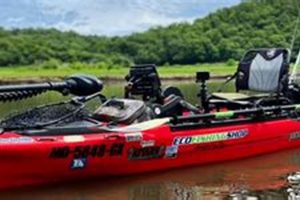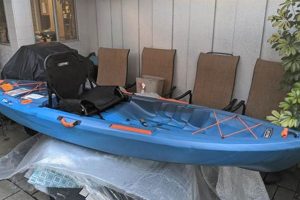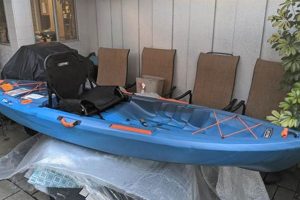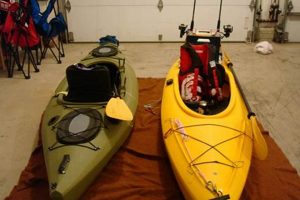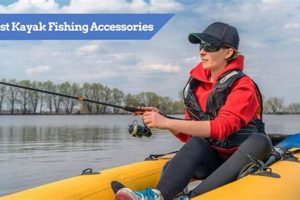Specialized equipment designed to enhance angler experiences while fishing from kayaks in Australian waters encompasses a wide range of products. These include rod holders, fish finders, tackle storage solutions, anchors, and safety gear like personal flotation devices and communication equipment. For example, a kayak angler might utilize a GPS-enabled fish finder to locate fish, specialized rod holders to secure fishing rods while paddling, and a dry bag to protect electronic devices and personal items.
The right gear significantly improves angler safety, comfort, and fishing success. Historically, kayak fishing relied on simpler tools, but advancements in materials and technology have led to a dedicated market catering specifically to this growing sport in Australia. This specialized equipment allows anglers to access previously unreachable fishing spots, stay organized on the water, and maximize their chances of a successful catch while prioritizing safety. The unique conditions and species found in Australian waters necessitate gear designed to withstand these specific challenges, ranging from saltwater corrosion to diverse fish species and varying weather conditions.
This article will further explore various categories of equipment crucial for kayak fishing in Australia, discussing specific product examples, selection criteria, and proper usage techniques. Topics covered will include electronics, safety equipment, storage solutions, and specialized fishing gear tailored to the Australian environment. Furthermore, the article will address the importance of responsible fishing practices and the preservation of Australias unique aquatic ecosystems.
Essential Tips for Equipping a Kayak for Fishing in Australia
Proper equipment selection is crucial for a safe and successful kayak fishing experience in Australia. The following tips offer guidance for choosing and utilizing essential gear.
Tip 1: Prioritize Safety Gear: A personal flotation device (PFD) designed for kayak fishing is paramount. Choose a high-visibility PFD with ample pockets for small tools and accessories. A waterproof VHF radio and a signaling device, such as a flare or whistle, are also essential for emergencies.
Tip 2: Select Appropriate Rod Holders: Rod holders should securely hold rods while paddling and allow for easy access when fighting fish. Consider adjustable rod holders that accommodate different rod lengths and fishing styles. Flush-mount rod holders offer a streamlined profile while minimizing interference with paddling.
Tip 3: Choose a Suitable Fish Finder: A fish finder provides crucial information about water depth, bottom structure, and fish location. Compact, portable fish finders designed for kayaks are ideal, offering convenient mounting options and clear displays.
Tip 4: Invest in Reliable Anchoring Systems: A well-chosen anchor prevents drifting and keeps the kayak positioned in desirable fishing locations. Anchor trolleys allow for precise anchor placement and control, particularly in windy conditions or strong currents.
Tip 5: Organize Tackle with Efficient Storage: Tackle boxes and bags designed specifically for kayak fishing maximize storage space and keep essential gear organized and accessible. Waterproof options safeguard against accidental submersion.
Tip 6: Consider a Kayak Cart for Transportation: Transporting a fully loaded kayak can be challenging. A kayak cart simplifies this process, reducing strain and allowing anglers to access launch points further from parking areas.
Tip 7: Protect Electronics with Dry Bags and Cases: Electronic devices, such as phones, GPS units, and cameras, should be protected from water damage. Waterproof dry bags and cases provide essential protection and peace of mind.
By following these tips, anglers can significantly enhance their safety, comfort, and overall fishing success on the water. Proper equipment selection enables efficient fishing practices and allows for greater enjoyment of Australia’s diverse aquatic environments.
In conclusion, these considerations are vital for optimizing kayak fishing excursions. By prioritizing safety, selecting appropriate gear, and emphasizing organization, anglers can maximize their enjoyment on the water while contributing to responsible fishing practices.
1. Safety Equipment
Safety equipment is paramount for kayak fishing in Australia, forming a crucial subset of essential accessories. The Australian environment presents unique challenges, from remote locations to diverse weather conditions, necessitating specific safety considerations. Prioritizing safety ensures enjoyable and incident-free fishing excursions.
- Personal Flotation Devices (PFDs)
A properly fitted PFD is non-negotiable. Australian regulations often mandate PFD usage, and choosing a type specifically designed for kayak fishing enhances comfort and mobility. These specialized PFDs incorporate features like high visibility colors, multiple pockets for storage, and attachment points for safety accessories. Selecting a PFD compliant with Australian Standards ensures it meets necessary buoyancy and safety requirements.
- Communication Devices
Reliable communication is vital in emergencies. A waterproof VHF radio enables contact with marine authorities and other vessels, especially crucial in remote Australian waters. Mobile phones, while useful, can suffer from limited reception in offshore areas. Carrying a personal locator beacon (PLB) provides an additional layer of security for signaling distress in life-threatening situations.
- Signaling Devices
Visual and auditory signaling devices are essential for attracting attention in emergencies. Flares, whistles, and mirrors can signal distress to nearby boats or rescue personnel. These devices should be readily accessible and in good working order. Understanding the proper use of flares and other signaling devices is crucial for effective communication in emergency situations.
- First-Aid Kit and Emergency Supplies
A comprehensive first-aid kit tailored to aquatic environments should be readily available. Essential items include waterproof bandages, antiseptic wipes, pain relievers, and seasickness medication. Additional emergency supplies like a knife, multi-tool, sunscreen, and extra drinking water further enhance preparedness for unexpected situations, especially given the often remote nature of kayak fishing locations in Australia.
These safety considerations are fundamental components of responsible kayak fishing in Australia. Investing in appropriate safety equipment demonstrates a commitment to personal well-being and allows anglers to focus on enjoying their fishing experience with peace of mind. Understanding the specific challenges posed by the Australian environment and selecting suitable safety measures significantly mitigates risks and enhances overall safety on the water.
2. Rod Holders
Rod holders are integral components within the broader context of kayak fishing accessories in Australia. They provide secure storage and convenient access to fishing rods, enabling anglers to manage their equipment effectively while navigating Australian waterways. Proper rod placement enhances safety, prevents tangling, and allows for quick reactions when fish strike. Selecting appropriate rod holders contributes significantly to an efficient and enjoyable fishing experience.
- Types of Rod Holders
Various rod holder designs cater to different fishing styles and kayak configurations. Flush-mount rod holders integrate seamlessly with the kayak’s deck, minimizing obstruction while paddling. Adjustable rod holders offer versatility in positioning rods at different angles, accommodating various fishing techniques. Rail-mounted rod holders attach to existing kayak rails, providing flexibility in placement. Understanding the advantages of each type allows anglers to choose the most suitable option for their specific needs and kayak setup within the Australian context.
- Material and Construction
Rod holders are typically constructed from durable materials designed to withstand the harsh Australian marine environment. UV-resistant plastics and corrosion-resistant metals ensure longevity and reliable performance. Reinforced designs provide additional strength and stability, particularly when battling larger fish species commonly encountered in Australian waters. Choosing robust and well-constructed rod holders safeguards against equipment failure in demanding conditions.
- Placement and Positioning
Strategic placement of rod holders is crucial for efficient kayak fishing. Positioning rod holders within easy reach allows for quick access while maintaining balance and stability. Anglers often utilize multiple rod holders to accommodate different rods and fishing techniques, facilitating diverse angling approaches in various Australian fishing locations. Careful consideration of rod placement optimizes fishing efficiency and minimizes interference with paddling and other onboard activities.
- Safety Considerations
Properly secured rods are essential for safety while kayak fishing. Rod holders should firmly grip the rods, preventing them from dislodging during paddling or in rough conditions. Ensuring rods are positioned to avoid entanglement with other equipment or anglers enhances safety and prevents accidents. Careful attention to these safety considerations contributes to a more secure and enjoyable fishing experience in Australian waters.
The selection and placement of rod holders directly impact the overall kayak fishing experience in Australia. By carefully considering factors like rod holder type, material, positioning, and safety implications, anglers can optimize their setup for efficiency, comfort, and safety, allowing them to fully appreciate the diverse fishing opportunities available in Australian waters.
3. Fish Finders
Fish finders represent a crucial technological advantage for kayak anglers in Australia, significantly enhancing their ability to locate fish and understand underwater environments. Within the broader category of kayak fishing accessories in Australia, fish finders play a pivotal role in increasing fishing success and efficiency. Understanding their features and functionality is essential for maximizing their potential in the diverse aquatic landscapes found across Australia.
- Transducer Types and Mounting
Various transducer types exist, each with specific characteristics suited to different kayak fishing scenarios. Transom-mount transducers attach to the kayak’s stern, while through-hull transducers offer optimal performance but require more complex installation. Portable transducers provide flexibility for temporary mounting and are well-suited to kayak fishing. Choosing the right transducer for Australian conditions, whether navigating shallow estuaries or deeper offshore waters, significantly impacts fish finder accuracy and effectiveness.
- Display Technology and Interpretation
Modern fish finders utilize advanced display technologies to present underwater information clearly. CHIRP sonar provides detailed images of fish and bottom structure, while DownScan Imaging offers photo-like visuals of the underwater terrain. Understanding how to interpret these displays, including identifying fish arches, bottom contours, and vegetation, is crucial for effective fishing in Australia’s varied aquatic environments. This knowledge allows anglers to pinpoint ideal fishing locations and target specific species based on their habitat preferences.
- GPS Integration and Navigation
Many fish finders incorporate GPS technology, allowing anglers to mark waypoints, track their movements, and navigate to productive fishing spots. This feature is particularly valuable in Australia’s vast coastal and inland waterways, enabling anglers to revisit successful locations and explore new areas with confidence. GPS integration enhances safety by providing accurate location information, especially important in remote Australian fishing locations.
- Power Management and Battery Life
Efficient power management is essential for extended kayak fishing trips. Fish finders consume power, and choosing a unit with optimized battery life or utilizing external power sources ensures uninterrupted operation throughout the day. Understanding power consumption and managing battery resources effectively is especially crucial in remote Australian locations where access to charging facilities may be limited.
The integration of fish finders into kayak fishing setups significantly enhances angling success in Australia. By carefully considering transducer type, display features, GPS capabilities, and power management strategies, kayak anglers can maximize their understanding of underwater environments and improve their chances of locating and catching target species. Effective use of fish finders contributes significantly to a more informed, efficient, and ultimately, more rewarding fishing experience in the diverse waters of Australia.
4. Anchoring Systems
Anchoring systems represent a critical component within the broader category of kayak fishing accessories specifically tailored for Australian conditions. Effective anchoring enables anglers to maintain position in desired fishing locations, counteracting the effects of wind, currents, and tidal movements prevalent in Australian waters. This capability is particularly crucial in diverse environments ranging from estuaries and bays to offshore reefs and open ocean areas where maintaining precise location is essential for successful fishing. For example, anchoring allows anglers to target specific structures like drop-offs or reefs, maximizing their chances of encountering target species common to Australian waters. Without a reliable anchoring system, drift and unwanted movement can significantly hinder fishing effectiveness and even compromise safety. The connection between anchoring systems and successful kayak fishing in Australia is fundamental, linking directly to angler effectiveness and overall fishing experience.
Several anchoring system options cater to various kayak fishing scenarios within Australia. Folding grapnel anchors are popular for their compact size and strong holding power in a variety of bottom conditions. Sand anchors, designed for sandy or muddy substrates common in Australian estuaries and bays, offer reliable holding in these specific environments. Drift chutes provide controlled drift in windy conditions, useful for targeting pelagic species. Anchor trolleys facilitate precise anchor placement and allow for adjustments based on wind or current changes, crucial for maintaining optimal fishing positions in dynamic Australian waters. Understanding these various options and selecting the most appropriate anchoring system based on specific fishing locations and conditions significantly enhances angling effectiveness and contributes to a more controlled and productive fishing experience.
Successful deployment and retrieval of anchoring systems requires specific techniques and considerations. Selecting appropriate anchor line length and material is crucial for effective anchoring, factoring in water depth and bottom composition prevalent in Australian waters. Proper deployment techniques ensure the anchor sets securely, minimizing drag and maximizing holding power in varying conditions. Safe and efficient retrieval methods prevent entanglement and equipment damage. Furthermore, understanding anchoring regulations and best practices for minimizing environmental impact is essential for responsible kayak fishing in Australia. Mastery of these practical aspects further solidifies the importance of anchoring systems as an integral part of successful and sustainable kayak fishing practices in the diverse Australian aquatic landscape.
5. Storage Solutions
Effective storage solutions are essential components within the broader context of kayak fishing accessories in Australia. Organized storage directly impacts fishing efficiency and safety, allowing anglers to readily access necessary gear while maintaining a stable and uncluttered kayak. Given the limited space inherent in kayak fishing, especially in the diverse and sometimes challenging conditions encountered in Australian waters, efficient storage becomes paramount. Proper organization of tackle, tools, and safety equipment contributes significantly to a more streamlined and successful fishing experience.
- Tackle Management Systems
Specialized tackle boxes and trays designed for kayak fishing maximize storage capacity within limited space. Modular systems allow for customization based on individual angler needs, accommodating various lure types, hooks, and other terminal tackle commonly used when targeting species found in Australian waters. Waterproof containers protect sensitive gear from saltwater and spray, crucial in the often-wet conditions encountered while kayak fishing in Australia. Efficient tackle management enables quick lure changes and adjustments, maximizing fishing time and responsiveness to changing conditions.
- Dry Bags and Waterproof Cases
Protecting electronic devices, personal items, and essential gear from water damage is paramount in kayak fishing. Waterproof dry bags and cases provide secure storage for phones, cameras, wallets, and other valuables, safeguarding them from splashes, rain, and accidental submersion, which are potential risks in Australian waters. These storage solutions offer peace of mind, allowing anglers to focus on fishing without concern for their belongings. The Australian climate, with its potential for sudden weather changes, further underscores the importance of waterproof storage in kayak fishing.
- On-Deck Storage and Mounting Options
Utilizing available space on the kayak’s deck efficiently is crucial for maximizing storage capacity. Deck bags, mounted securely to the kayak, provide readily accessible storage for frequently used items. Bungee cords and straps secure additional gear, ensuring it remains within reach but prevents clutter. Rod holders, often integrated with storage compartments, offer dual functionality. Strategic placement of these on-deck storage solutions optimizes space utilization and maintains a balanced kayak, crucial for stability, particularly in the variable conditions encountered in Australian waters.
- Creative Storage Solutions for Kayaks
Innovative storage solutions cater specifically to the unique space constraints of kayak fishing. Utilizing spaces within hatches and under seats maximizes storage potential. Custom-designed storage inserts and organizers further optimize space utilization. Milk crates and other readily available containers can be adapted for kayak storage, offering cost-effective solutions. Exploiting these creative storage options contributes to a more organized and efficient kayak setup, essential for enjoyable and productive fishing excursions in Australia.
Effective storage solutions are integral to optimizing kayak fishing experiences in Australia. By prioritizing organization and utilizing specialized storage options, anglers can streamline their gear management, enhance safety, and maximize their time on the water. These practical considerations contribute significantly to a more enjoyable and productive fishing experience in the diverse Australian environment.
6. Kayak Carts
Kayak carts represent a crucial logistical component within the broader ecosystem of kayak fishing accessories in Australia. Transporting kayaks, often laden with fishing gear, from vehicle to launch site can be physically demanding, especially across challenging terrain like sandy beaches or rocky shorelines common in Australian coastal areas. Kayak carts alleviate this burden, facilitating easier and more efficient transport, which is particularly important for anglers accessing remote fishing locations or those with physical limitations. This aspect of kayak fishing logistics is often overlooked but significantly impacts the overall fishing experience, especially in the diverse and sometimes demanding Australian environment.
- Cart Types and Terrain Compatibility
Various kayak cart designs cater to different terrains and kayak types. Plug-in carts attach directly to scupper holes, while strap-on carts offer broader compatibility. Inflatable balloon carts excel on soft sand, prevalent in many Australian beach launch sites. Choosing a cart appropriate for the intended terrain, whether it’s the sandy beaches of Queensland or the rocky shores of Tasmania, ensures efficient transport and minimizes strain on both the angler and the kayak. Understanding terrain compatibility is crucial for selecting the most effective cart for specific Australian fishing locations.
- Construction and Durability
Kayak carts intended for Australian conditions should be constructed from robust, corrosion-resistant materials. Aluminum or stainless steel frames provide strength and durability, withstanding the harsh saltwater environment. Pneumatic tires with sufficient tread offer good traction on various surfaces, including sand, gravel, and rocky terrain common in Australia. Durable construction ensures reliable performance over time, especially important given the often challenging transport conditions encountered in Australian kayak fishing environments.
- Ease of Use and Portability
Kayak carts should be easy to assemble, disassemble, and stow. Compact designs and lightweight materials facilitate portability, minimizing storage space on the kayak. Quick-release mechanisms allow for rapid deployment and removal, streamlining the transition from transport to launch. These practical considerations enhance the overall user experience, particularly in remote Australian locations where efficiency and ease of use are paramount.
- Weight Capacity and Kayak Compatibility
Considering the weight capacity of a kayak cart is essential, factoring in the combined weight of the kayak and fishing gear. Overloading a cart can lead to instability and equipment damage. Ensuring compatibility with the specific kayak’s hull shape and size is also crucial for secure transport. Addressing these weight and compatibility factors ensures safe and efficient transport in varied Australian environments and contributes to the longevity of both the cart and the kayak.
While seemingly a peripheral concern, kayak carts play a pivotal role in enhancing the overall kayak fishing experience in Australia. Facilitating easier transport to and from launch sites, they reduce physical strain and allow anglers to focus on the fishing itself. By carefully considering factors such as terrain compatibility, durability, ease of use, weight capacity, and kayak compatibility, anglers can select a kayak cart that effectively addresses the specific logistical challenges presented by the Australian environment, ultimately contributing to a more enjoyable and productive fishing experience. This seemingly simple piece of equipment significantly contributes to the accessibility and overall success of kayak fishing expeditions in Australia.
Frequently Asked Questions about Kayak Fishing Accessories in Australia
This FAQ section addresses common queries regarding essential equipment for kayak fishing in Australia. Understanding these aspects contributes significantly to informed decision-making and enhances overall fishing experiences.
Question 1: What is the most important safety accessory for kayak fishing in Australia?
A properly fitted personal flotation device (PFD) compliant with Australian Standards is paramount for kayak fishing safety. Choosing a PFD specifically designed for kayak fishing enhances comfort and mobility while providing essential buoyancy in case of capsize.
Question 2: How does one choose appropriate rod holders for a kayak?
Rod holder selection depends on individual fishing styles and kayak configurations. Flush-mount, adjustable, and rail-mounted rod holders offer varying functionalities. Material durability and corrosion resistance are crucial, especially in the Australian saltwater environment. Placement should prioritize easy access and minimize interference with paddling.
Question 3: Which type of fish finder is best suited for kayak fishing in Australia?
Compact, portable fish finders with transducer options suitable for Australian conditions are ideal. Consider display clarity, GPS integration, and power management capabilities. CHIRP sonar and DownScan Imaging offer enhanced underwater visualization, beneficial in Australia’s diverse aquatic environments.
Question 4: What are the essential components of a reliable kayak anchoring system for Australian waters?
Appropriate anchor selection depends on bottom composition and prevailing conditions. Folding grapnel anchors, sand anchors, and drift chutes offer various functionalities. Anchor trolleys enhance placement control. Anchor line length and material should be appropriate for Australian water depths and currents. Adhering to local anchoring regulations is essential.
Question 5: How can one optimize storage space on a fishing kayak in Australia?
Utilizing specialized tackle boxes, waterproof dry bags, and deck-mounted storage solutions maximizes space efficiency. Creative storage solutions like hatch inserts and under-seat organizers further optimize gear organization. Prioritizing essential items and minimizing unnecessary clutter contributes to a more streamlined and stable kayak setup.
Question 6: What factors should be considered when choosing a kayak cart for Australian conditions?
Terrain compatibility, cart construction, ease of use, weight capacity, and kayak compatibility are key considerations. Durable materials like aluminum or stainless steel and pneumatic tires are ideal for Australian environments. Compactness and portability are advantageous for transport and storage.
Careful consideration of these frequently asked questions ensures anglers are well-equipped to make informed decisions regarding essential accessories for kayak fishing in Australia. Prioritizing safety, functionality, and environmental responsibility contributes significantly to enjoyable and productive fishing experiences.
The subsequent section will delve into specific product recommendations and reviews, offering further guidance in selecting appropriate kayak fishing accessories tailored to the Australian environment.
Kayak Fishing Accessories Australia
Careful selection of kayak fishing accessories tailored to Australian conditions significantly enhances safety, efficiency, and overall fishing success. This article explored essential equipment categories, including safety gear, rod holders, fish finders, anchoring systems, storage solutions, and kayak carts. Each category plays a vital role in optimizing fishing experiences within Australia’s diverse aquatic environments, from sheltered estuaries to challenging offshore waters. Emphasis was placed on selecting appropriate gear based on individual needs, fishing styles, and the specific challenges posed by the Australian environment. Durable construction, corrosion resistance, and reliable performance are paramount considerations given the demanding conditions often encountered in Australian waters.
Investing in appropriate kayak fishing accessories represents a commitment to both safety and fishing success. Proper equipment selection enables anglers to navigate Australia’s varied waterways effectively, maximize fishing opportunities, and contribute to responsible angling practices. Further research and consultation with experienced kayak anglers will enhance understanding and facilitate informed decision-making. Ultimately, the appropriate selection and utilization of kayak fishing accessories in Australia contribute significantly to positive and productive fishing experiences while promoting the long-term health of Australia’s unique aquatic ecosystems.


